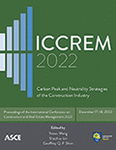Research on Carbon Emissions Measurement during Materialization Stage of Prefabricated Buildings: A Case Study of Urban Renewal Project in Guangzhou
Publication: ICCREM 2022
ABSTRACT
Prefabricated buildings (PBs) play a significant role in improving the efficiency of carbon emission reduction and accelerating the goal of carbon neutrality in the construction industry. Based on the emission factor method, this study establishes a carbon emission calculation model for the materialization stage of PBs from three phases: production, transportation, and construction, and applies it to compute carbon emissions of a case study in Guangzhou, China. The results show that (1) the main contribution of carbon emissions in the materialization stage comes from the production of concrete and steel reinforcement, whose carbon emissions account for 42.43% and 41.04% of the total; (2) the carbon emissions of the production phase account for 94.63% of the total, and the carbon emissions of the transportation and construction phases are equivalent, a result consistent with traditional cast-in-place buildings; and (3) the carbon emission intensity of PBs is 435.34 kgCO2eq/m2 in the materialization stage, which is significantly lower than that of traditional cast-in-place buildings.
Get full access to this article
View all available purchase options and get full access to this chapter.
REFERENCES
Belić, D. S. (2006). “Global warming and greenhouse gases.” Facta Universitatis-Series: Physics, Chemistry and Technology, 4(1), 45–55.
Chen, Y., and Zhu, Y. (2010). “Models for life-cycle energy consumption and environmental emissions in residential buildings.” Journal of Tsinghua University (Science and Technology), 50(3), 325–329. (in Chinese).
Ding, Z. K., Liu, S., Luo, L. W., and Liao, L. H. (2020). “A building information modeling-based carbon emission measurement system for prefabricated residential buildings during the materialization phase.” Journal of Cleaner Production, 264, 121728.
Dong, L., Wang, Y., Li, H. X., Jiang, B., and Al-Hussein, M. (2018). “Carbon reduction measures-based LCA of prefabricated temporary housing with renewable energy systems.” Sustainability, 10(3), 718.
Du, Q., Bao, T., Li, Y., Huang, Y. D., and Shao, L. (2019). “Impact of prefabrication technology on the cradle-to-site CO2 emissions of residential buildings.” Clean Technologies and Environmental Policy, 21(7), 1499–1514.
Gao, X., Zhu, J. J., and Chen, M. (2019). “Research on calculation model of carbon footprint in prefabricated concrete building phase.” Building Energy Saving, 47(2), 97–101.
Hao, J. L., Cheng, B. Q., Lu, W. S., Xu, J., Wang, J. J., Bu, W. C., and Guo, Z. P. (2020). “Carbon emission reduction in prefabrication construction during materialization stage: A BIM-based life-cycle assessment approach.” Science of the Total Environment, 723, 137870.
Hong, J. K., Shen, G. Q., Feng, Y., Lau, W. S. T., and Mao, C. (2015). “Greenhouse gas emissions during the construction phase of a building: A case study in China.” Journal of Cleaner Production, 103, 249–259.
Kong, A., Kang, H., He, S., Li, N., and Wang, W. (2020). “Study on the carbon emissions in the whole construction process of prefabricated floor slab.” Applied Sciences, 10, 2326.
Kumanayake, R., and Luo, H. B. (2018). “Life cycle carbon emission assessment of a multi-purpose university building: A case study of Sri Lanka.” Front. Eng. Manag, 5, 381–393.
Li, X. D., Zhu, Y. M., and Zhang, Z. H. (2010). “An LCA-based environmental impact assessment model for construction processes.” Building and Environment, 45(3), 766–775.
Li, X. J., Lai, J. Y., Ma, C. Y., and Wang, C. (2021). “Using BIM to research carbon footprint during the materialization phase of prefabricated concrete buildings: A China study.” Journal of Cleaner Production, 279, 123454.
Li, X. J., Xie, W. J., Jim, C. Y., and Feng, F. (2021). “Holistic LCA evaluation of the carbon footprint of prefabricated concrete stairs.” Journal of Cleaner Production, 329, 129621.
Li, X. J., and Zheng, Y. D. (2020). “Using LCA to research carbon footprint for precast concrete piles during the building construction stage: A China study.” Journal of Cleaner Production, 245, 118754.
Liu, G. W., Gu, T. Y., Xu, P. P., Hong, J. K., Shrestha, A., and Martek, I. (2019). “A production line-based carbon emission assessment model for prefabricated components in China.” Journal of Cleaner Production, 209, 30–39.
Lu, W. S., Chen, X., Peng, Y., and Liu, X. J. (2018). “The effects of green building on construction waste minimization: Triangulating ‘big data’ with ‘thick data’.” Waste Management, 79, 142–152.
Wu, G. B., Yang, R., Li, L., Bi, X., Liu, B. S., Li, S. Y., and Zhou, S. X. (2019). “Factors influencing the application of prefabricated construction in China: From perspectives of technology promotion and cleaner production.” Journal of Cleaner Production, 219, 753–762.
Wu, P., Xia, B., Pienaar, J., and Zhao, X. B. (2014). “The past, present and future of carbon labelling for construction materials: A review.” Building and Environment, 77, 160–168.
Xu, K. T., Kang, H. B., Wang, W., Jiang, P., and Li, N. (2021). “Carbon emission estimation of assembled composite concrete beams during construction.” Energies, 14, 1810.
Yang, L., Yan, H. Y., and Lam, J. C. (2014). “Thermal comfort and building energy consumption implications: A review.” Applied Energy, 115, 164–173.
Zhang, L., Wu, J., and Liu, H. Y. (2018). “Policies to enhance the drivers of green housing development in China.” Energy Policy, 121, 225–235.
Zhang, X. L., Luo, L. Z., and Skitmore, M. (2015). “Household carbon emission research: An analytical review of measurement, influencing factors and mitigation prospects.” Journal of Cleaner Production, 103, 873–883.
Zhu, Y., and Chen, Y. (2010). “Cases for life-cycle energy consumption and environmental emissions in residential buildings.” Journal of Tsinghua University (Science and Technology), 50(3), 330–334. (in Chinese).
Information & Authors
Information
Published In
History
Published online: Dec 15, 2022
Authors
Metrics & Citations
Metrics
Citations
Download citation
If you have the appropriate software installed, you can download article citation data to the citation manager of your choice. Simply select your manager software from the list below and click Download.
